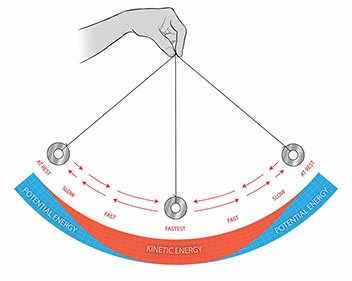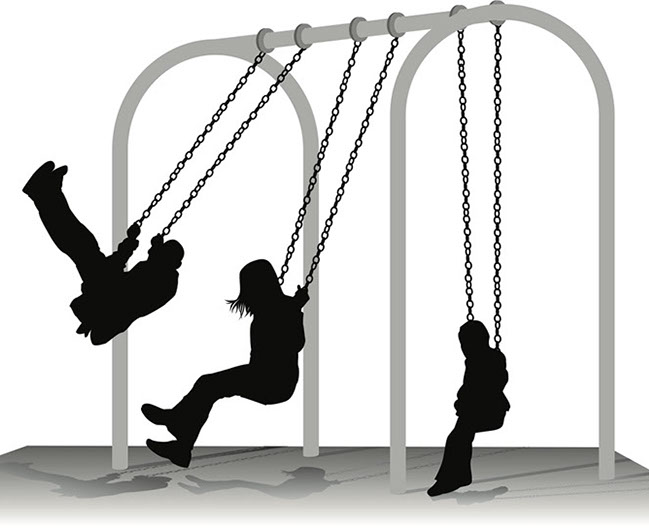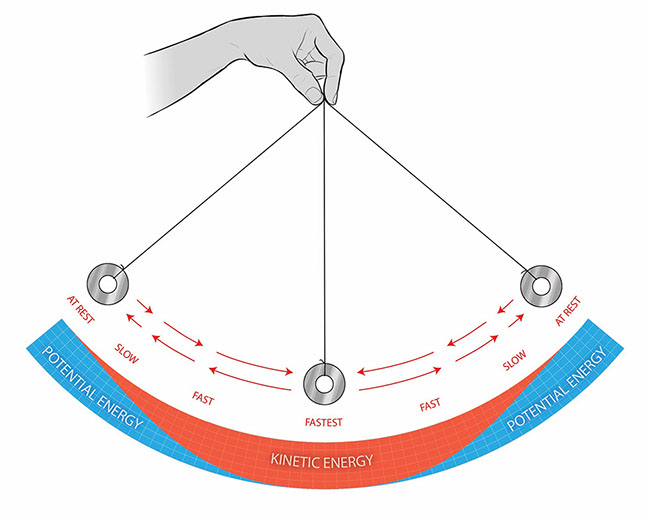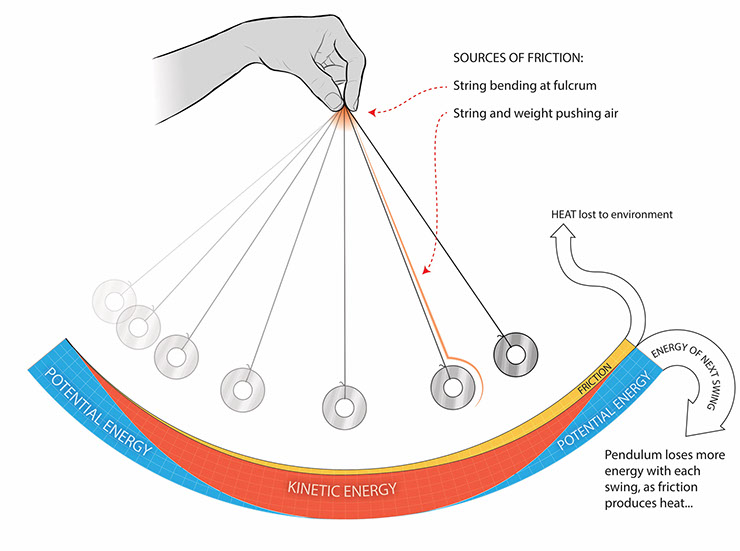SciGen Teacher Dashboard
Unit E1
Potential and Kinetic Energy
Lab: Pendulum Energy
 Duration: Approximately 60 minutes
Duration: Approximately 60 minutes
By considering the playground swing, looking at diagrams, and using real-world pendulums, students understand how kinetic and potential energy relate within a system.
LEARNING OBJECTIVES
Students understand how kinetic and potential energy relate within a system. Students understand the impact of friction on the energy within a system.
Students construct and interpret graphical displays of data to describe the relationships of kinetic energy to the mass of an object and to the speed of an object.
Students construct, use, and present arguments to support the claim that when the kinetic energy of an object changes, energy is transferred to or from the object.
Teacher Tips
- If you happen to teach near a swing set, Part 1 of this activity is a great opportunity to take a mini field trip, either to observe younger children swinging or to experience the swing of a pendulum kinesthetically.
Materials
- small metal washer (or similar)
- string
Teacher Tune-ups
Teaching Notes
ACTIVITY OVERVIEW
- Kinetic and potential energy within a system (15 minutes)
- Consider the pendulum as a system (15 minutes)
- More about the pendulum and its energy (15 minutes)
- What about friction? (15 minutes)
Kinetic and potential energy within a system (15 minutes)
This illustration is intended to expand the concept that an object can have both kinetic and potential energy. Three children are swinging and each is in a different position. Students are asked to consider which child has the most potential energy and which has the most kinetic energy.
You may ask students to think for a moment, write down a response, and then to discuss within a group or with a partner. In any case, allow sufficient time for students to justify their responses.
It isn’t essential that students understand all concepts at this point.
:
- Child #1 appears to be just sitting on the swing. So this child has little or no kinetic or potential energy.
- Child #3 is at the top of the arc of his swing. If he is exactly at the top of the swing, he is not moving up or moving down (zero kinetic energy). He is motionless for just a split second before moving down. In this case he has no kinetic energy but plenty of potential energy. In another split second he will plummet down and have kinetic energy. It is improbable that a child is completely stationary, so even if at the exact top of the swing, he has both kinetic and potential energies.
- Child #2 is moving backwards. She now has the greatest amount of kinetic energy of the three children. Her velocity is greatest of the three. She also appears to be the largest child, so her mass is the highest. Her momentum is also the greatest.
- Child #1 has the least potential energy, zero. Child #3 has more potential energy than Child #2 (even though Child #2 appears to have more mass), because the center of mass of Child #3 is about four times further above the bottom of the arcs than that of Child #2.
Sometimes objects have both kinetic and potential energy. Let’s say that Child #1 is just sitting on the swing and not moving at all. Child #2 is moving backward. Her position moments ago was just like Child #3. Speaking of Child #3, he is at the very highest point of his swing.
TURN AND TALK:
Of the three children swinging, which is displaying the most kinetic energy? The most potential energy?
Explain your thinking:
Is there another point at which Child #2 or #3 will have more kinetic energy? More potential energy?
Consider the pendulum as a system (15 minutes)
Making a Pendulum: Have students make a pendulum to investigate how potential energy becomes kinetic energy and how kinetic energy becomes potential energy.
Any thin cotton string or strong thread will do for this demonstration. A thick string won’t swing well. Washers are easy to tie and heavy, but other objects will work. The washer should be at least ½ inch in diameter. (Smaller ones aren’t heavy enough.)
:
One student holds the end of the string while the second holds the washer so that the string is taut and then releases the washer. The person holding the string shouldn’t move his or her hand – no fair swinging the washer!
Ask students to think about what kind of energy the pendulum has when the washer is in different positions: when it is at the top of the swing, halfway to the bottom, at the bottom, and halfway to the top.
Students should discuss the questions with their partners and then write their conclusions. Consider having students present their responses to the whole class.
:
- Does the length of the string affect the period?
- The mass of the washer?
- Point of release?
More about the pendulum and its energy (15 minutes)
This illustration and graph describe how and when energy transfers on a simple pendulum.
:
As the washer swings down, potential energy is transformed into kinetic energy. At the bottom of the swing all energy is kinetic energy. As the washer moves up, kinetic energy is transformed into potential energy. At its highest point in the arc of the swing, once again the energy is all potential energy.
:
When your partner moved the washer to the left or right from its resting position, he or she gave the pendulum potential energy. It was potential energy because the washer could swing due to its relative position and gravity. This kind of potential energy is known as gravitational potential energy.
What’s interesting about a pendulum, though, is that when you let go of it, the potential energy gradually transforms into kinetic energy. And then it gets faster and faster until it reaches the lowest point of the swing. At that point the kinetic energy starts transforming back into potential energy on the other end of the swing. Then, the pendulum actually comes to a stop! It comes to a stop for a very short time at the end of each swing. When it is “at rest” the energy is once again potential energy.
With this great system going, you might think the pendulum would never stop. But as you observed, it does indeed stop swinging after a while. But why? Where did all that energy go?
What about friction? (15 minutes)
:
The transfer repeats as the washer swings to the right and left. Friction eventually slows and stops the motion. Friction is the force that holds back a moving object. Friction is present where your fingers meet the string and where the string touches the washer.
In a system with no friction, the pendulum would continue to swing forever.
:
Why does the swinging slow over time?
:
(Many will offer gravity as the cause, but that is not the case.)
- The washer (and the string) is actually banging into something as it swings. But what? AIR MOLECULES, of course! Swing your hand back and forth and feel them for yourself! But an even more significant reason for the pendulum slowing down is the friction between the string and your fingers and the friction of the different parts of the string itself.
BETA Version - Please send comments and corrections to info@serpinstitute.org




